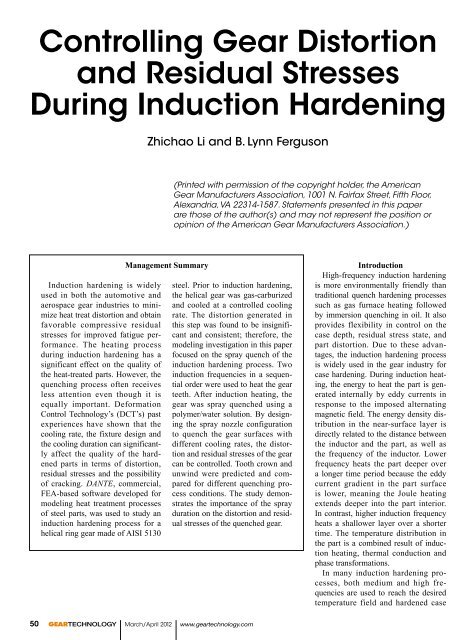Download PDF - Gear Technology magazine
Download PDF - Gear Technology magazine
Download PDF - Gear Technology magazine
You also want an ePaper? Increase the reach of your titles
YUMPU automatically turns print PDFs into web optimized ePapers that Google loves.
Controlling <strong>Gear</strong> Distortion<br />
and Residual Stresses<br />
During Induction Hardening<br />
Zhichao Li and B. Lynn Ferguson<br />
(Printed with permission of the copyright holder, the American<br />
<strong>Gear</strong> Manufacturers Association, 1001 N. Fairfax Street, Fifth Floor,<br />
Alexandria, VA 22314-1587. Statements presented in this paper<br />
are those of the author(s) and may not represent the position or<br />
opinion of the American <strong>Gear</strong> Manufacturers Association.)<br />
Induction hardening is widely<br />
used in both the automotive and<br />
aerospace gear industries to minimize<br />
heat treat distortion and obtain<br />
favorable compressive residual<br />
stresses for improved fatigue performance.<br />
The heating process<br />
during induction hardening has a<br />
significant effect on the quality of<br />
the heat-treated parts. However, the<br />
quenching process often receives<br />
less attention even though it is<br />
equally important. Deformation<br />
Control <strong>Technology</strong>’s (DCT’s) past<br />
experiences have shown that the<br />
cooling rate, the fixture design and<br />
the cooling duration can significantly<br />
affect the quality of the hardened<br />
parts in terms of distortion,<br />
residual stresses and the possibility<br />
of cracking. DANTE, commercial,<br />
FEA-based software developed for<br />
modeling heat treatment processes<br />
of steel parts, was used to study an<br />
induction hardening process for a<br />
helical ring gear made of AISI 5130<br />
Management Summary<br />
steel. Prior to induction hardening,<br />
the helical gear was gas-carburized<br />
and cooled at a controlled cooling<br />
rate. The distortion generated in<br />
this step was found to be insignificant<br />
and consistent; therefore, the<br />
modeling investigation in this paper<br />
focused on the spray quench of the<br />
induction hardening process. Two<br />
induction frequencies in a sequential<br />
order were used to heat the gear<br />
teeth. After induction heating, the<br />
gear was spray quenched using a<br />
polymer/water solution. By designing<br />
the spray nozzle configuration<br />
to quench the gear surfaces with<br />
different cooling rates, the distortion<br />
and residual stresses of the gear<br />
can be controlled. Tooth crown and<br />
unwind were predicted and compared<br />
for different quenching process<br />
conditions. The study demonstrates<br />
the importance of the spray<br />
duration on the distortion and residual<br />
stresses of the quenched gear.<br />
Introduction<br />
High-frequency induction hardening<br />
is more environmentally friendly than<br />
traditional quench hardening processes<br />
such as gas furnace heating followed<br />
by immersion quenching in oil. It also<br />
provides flexibility in control on the<br />
case depth, residual stress state, and<br />
part distortion. Due to these advantages,<br />
the induction hardening process<br />
is widely used in the gear industry for<br />
case hardening. During induction heating,<br />
the energy to heat the part is generated<br />
internally by eddy currents in<br />
response to the imposed alternating<br />
magnetic field. The energy density distribution<br />
in the near-surface layer is<br />
directly related to the distance between<br />
the inductor and the part, as well as<br />
the frequency of the inductor. Lower<br />
frequency heats the part deeper over<br />
a longer time period because the eddy<br />
current gradient in the part surface<br />
is lower, meaning the Joule heating<br />
extends deeper into the part interior.<br />
In contrast, higher induction frequency<br />
heats a shallower layer over a shorter<br />
time. The temperature distribution in<br />
the part is a combined result of induction<br />
heating, thermal conduction and<br />
phase transformations.<br />
In many induction hardening processes,<br />
both medium and high frequencies<br />
are used to reach the desired<br />
temperature field and hardened case<br />
50<br />
GEARTECHNOLOGY March/April 2012 www.geartechnology.com
















